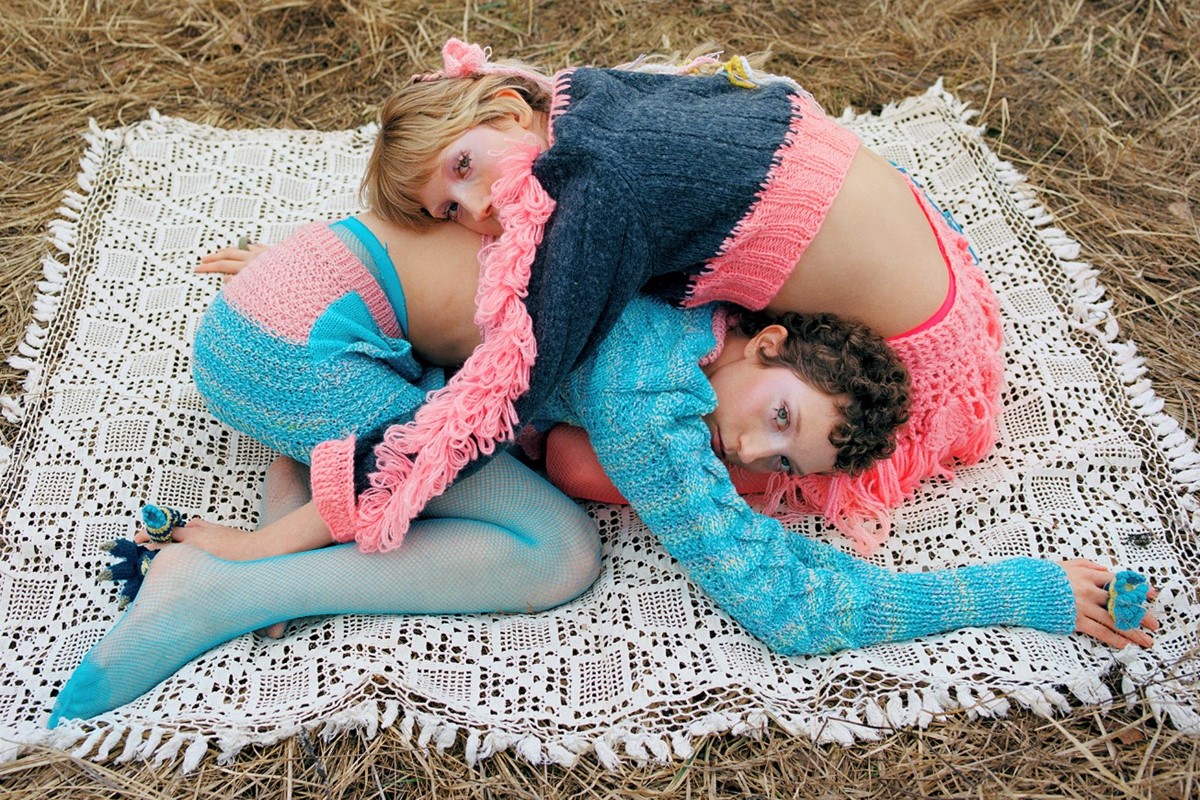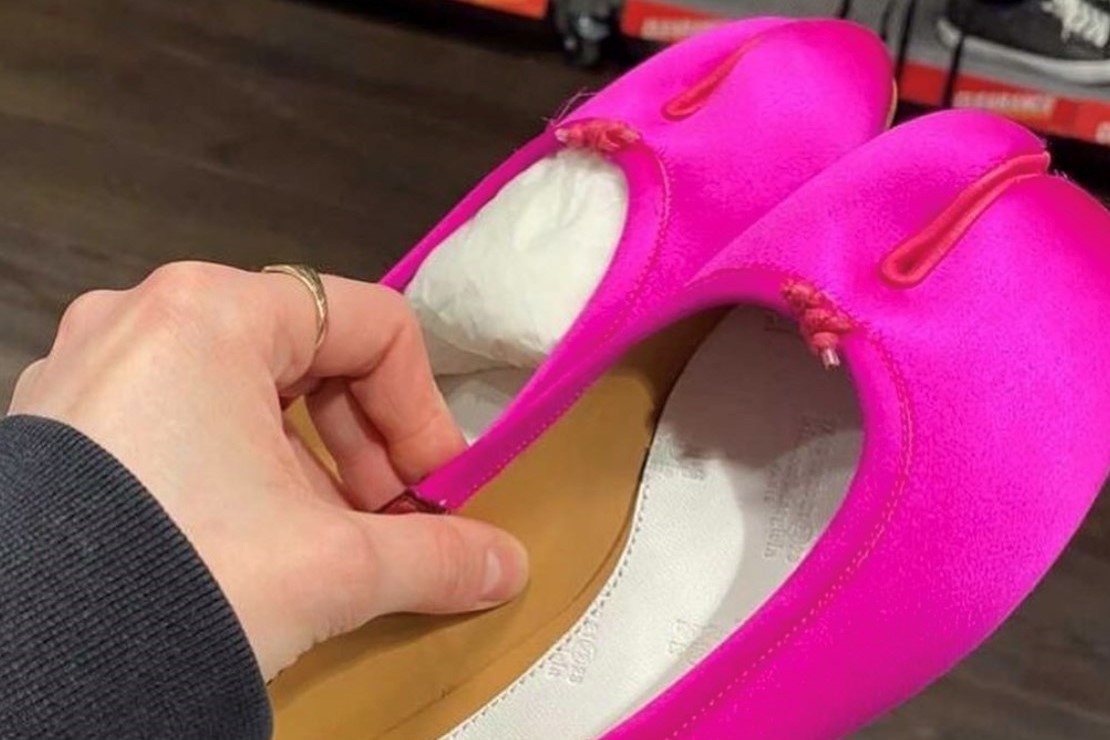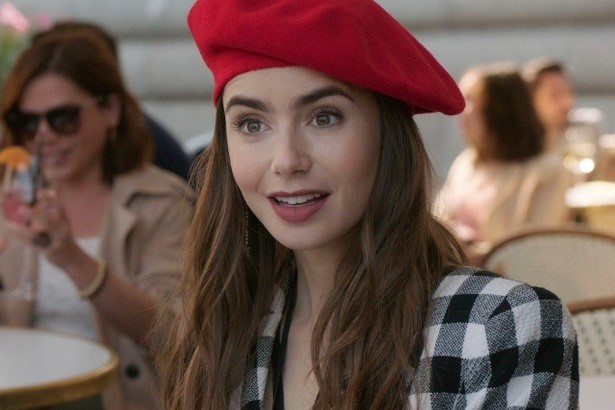
Folkloric label Vereja is knitting a new narrative for Russian fashion
Igor Andreev and Masha Komarova’s sexy, gender-fluid designs draw on long-forgotten fairytales and pagan traditions, proving there’s far more to Russian fashion than hardcore post-Soviet aesthetics
Many of us turned to crafts in order to cope with the pandemic-induced turmoil of the last year – but Igor Andreev has taken this to a whole new level. After years of working in fashion media, the Russian designer has returned to his childhood passion of knitting and, together with his friend Masha Komarova, created Vereja – a label redefining the traditions of Russian knitwear for a new generation.
Russian fashion is often associated with urban settings and post-Soviet heritage, with tower block estates, constructivist architecture, and rave-inspired sportswear dominating the runways in recent years. Vereja, however, shows a completely different and equally authentic side to Russia, tapping into enchanting rural settings, fairy tales, and pagan traditions for inspiration, and turning colourful balls of yarn into a celebration of gender-fluidity, sexuality, and the body.




All Vereja’s garments are hand-knitted, which is a pretty novel notion in the year 2021. The craft may have been passed down through generations, but, for the most part, it’s utterly foreign in the world of high fashion. Andreev himself grew up in the small village of Ustye in the Moscow region and only learnt to knit through craft workshops at a local school. Initially, he was forbidden to join classes as he was a boy, but, determined in his quest to learn these new skills, he insisted.
Looking back, knitted and crocheted garments were always around Andreev. From the cartoon character-emblazoned sweaters his mum would craft, to the handmade doilies that were dotted around the house, there decorative flourishes – inspired by childhood memories and personal history – are integral to the Vereja world. The label’s latest lookbook saw Andreev and Komarova return to Ustye village, while other striking imagery sees huge red doilies stacked on top of a Lada car. For these two designers, humble beginnings are not something to hide, but a creative resource worth celebrating.
Vereja’s AW21 collection is a story of two reclusive sisters – who may or may not be forest dwelling nymphs – leaving their home for a life in the city. An olde-worlde backdrop, perhaps, but the garments are linked to Russia’s more recent fashion history, too. The designer drew from his memories of how people used to dress in small Russian towns in the 90s and early 2000s – back when fashion was aspirational, exciting, and an excuse to dress up.
Within this collection, there are barbie-pink knits, hip-hugging lace trousers paired with sturdy rubber shoes, and studded deconstructed denim suits – none of which would look out of place in a music video from the Y2K era. Many of the garments have been made from upcycled materials like old tablecloths, doilies, and sweaters bought in second hand stores or donated by friends. Fashion, for the Vereja duo, is about individuality – making it happen with whatever is at hand.
Here, we talk to the Vereja founders about rural Russian fashion, their approach to gender, and making knitwear sexy.
So, how did the story of Vereja start?
Vereja: Igor used to work in fashion media in Moscow, as an editor-in-chief at Numero Russia. When the magazine closed he was out of work and returned to his childhood passion of knitting. In 2019, he crafted the brand’s first collection in just a few months. In 2020, there was the pandemic and then lockdown, which we spent with each other. This is when we decided to take Vereja from an art project to a proper fashion brand.
Has knitwear always been a part of your life?
Vereja: Igor grew up in a village just outside of Moscow, and knitting and crocheting was part of his life from the very start. His mum used to knit sweaters with cartoon characters for him and his sister. At some point, a kid’s crafts class started in his school. They didn’t want to admit Igor as it wasn’t supposed to be for boys, but he insisted. So as a child he learnt to knit doilies, stuffed toys, and then switched to Pokemons (which 20 years later ended up in Vereja collections). When spring came around and it got warmer, all the girls quit the classes. But Igor had no friends, and nothing to do, so he stayed working on projects for the local knitting fair with his teacher – crocheting flower arrangements and spider webs. Later, Igor’s aunt would buy him knitting magazines and yarns. Then, aged 12, Igor used to make tablecloths and doilies which his aunt used to sell at her work in the laundrette.
Does knitting have a special significance in Russian culture?
Vereja: In the Soviet times, knitting was very popular, probably because the choice of clothing was so scarce. Most women used to knit, and knitting magazines were highly sought after. We sometimes take classic patterns from the 80s and 90s and reinvent them for Vereja, like for these dragonfly trousers.
What do you love most about knitwear as a creative tool?
Vereja: Knitwear allows us to create unique patterns with just a yarn and a crochet. It’s easy to manipulate conventional knitwear patterns, creating your own unique versions without meticulous testing and technological research. These patterns are impossible to replicate on a machine – which means the garments are not only unique but very hard to copy.
Could you tell a little bit about your design and making process? Do you make everything by hand?
Vereja: Igor makes all the samples himself by hand, but the stock for KM20 is produced by professional knitters – all by hand as well. When it comes to the process, we often use vintage knitwear. Sometimes Igor can take a vintage garment, look at the shape or pattern and create something completely new around this fragment.
Are upcycling and sustainability important for you? How do you work in this direction?
Vereja: At the start, we didn’t have a particular agenda about this. But it seemed strange to create new clothes when the world is already full of garments we could repurpose or upcycle. It’s not only logical, but also more cost-effective. Buying new fabrics is often more expensive than a used sweater in a second-hand store. At the moment we make sweaters from old jumpers and use vintage tablecloths to make dresses. We recently also did a collaboration with Levi’s and Russian Vogue using vintage and faulty denim.
What are the things you’re most inspired by in the Russian culture? What would you like people outside Russia to know and appreciate more in your country?
Vereja: We love the remains of paganism, that very pure Russian culture which dates back to the times before the country got Westernised in the 18th century. We have a lot of holidays with pagan roots. For example, during Maslenitsa at the start of spring, people burn a doll which represents Winter and eat pancakes which symbolise sun. It’s a sort of mass event in Russia, they literally burn them in every park. Or the Slavic celebration of Ivana Kupala in the beginning of summer which is meant for finding your future brides or grooms. A couple of centuries ago, young people used to run around the woods half-naked and try to catch each other. Or Kolyadki before Christmas when people dress as demons and monsters and walk around the houses singing and asking for treats, kind of similar to Halloween.
What does ‘sexy’ mean in the world of Vereja? How do you explore body and sexuality in your collections?
Vereja: Everyone around us wants to feel sexy and show off their body. It’s first and foremost an expression of self-love. For us, this is what sexy means.
Your designs are mostly gender-fluid or genderless. What do you think about the idea of gender expression in fashion, and do you try to challenge gender norms in what you do?
Vereja: For us it’s pretty obvious that everyone can dress absolutely the way they like. Men can wear dresses, tights, and bras – and there is nothing wrong with that. Everyone should be able to choose to look whichever way they like regardless of gender.
What are your plans for developing Vereja in the near future?
Vereja: We would love to show in London and get stocked at Dover Street Market! And when we become very big, we want to reopen a textile factory in Vereja town which we named the brand after. Igor’s mum used to work at that factory, and they used to produce the first ever jeans in the USSR.



